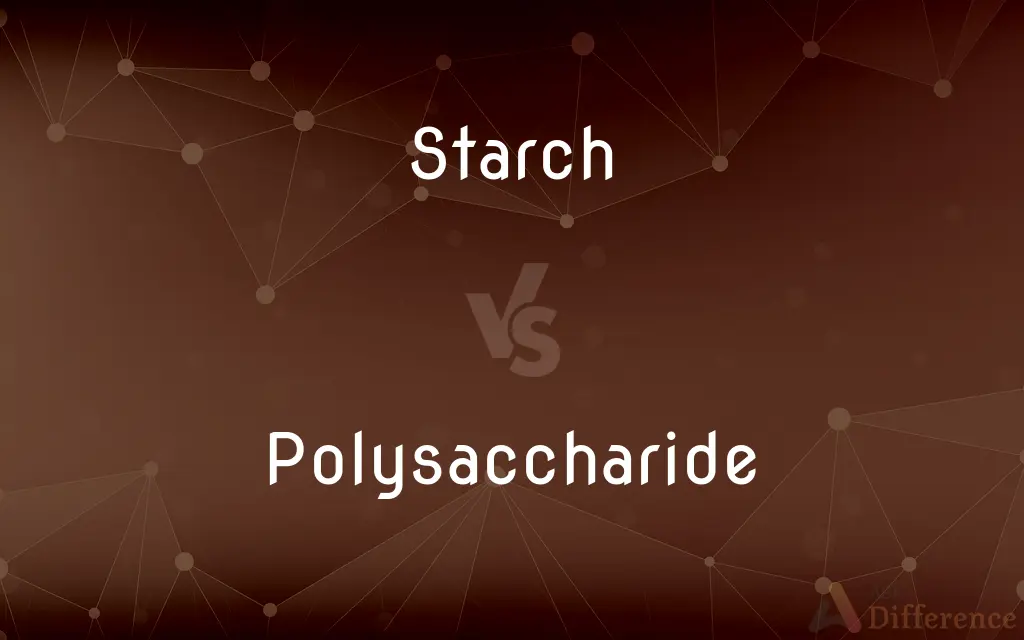Starch vs. Polysaccharide — What's the Difference?
Edited by Tayyaba Rehman — By Maham Liaqat — Updated on March 15, 2024
Starch is a type of polysaccharide composed of glucose units, primarily serving as energy storage in plants, while polysaccharides are a broad class of carbohydrates including starch and others like cellulose and glycogen.

Difference Between Starch and Polysaccharide
Table of Contents
ADVERTISEMENT
Key Differences
Starch, a polysaccharide found in many plants, acts as an energy reserve. It's made up of two types of molecules: amylose, which is linear, and amylopectin, which is branched. This composition gives starch its unique properties, such as its ability to thicken sauces and form gels. On the other hand, polysaccharides encompass a wide range of carbohydrate molecules, both linear and branched, that can serve various functions beyond energy storage, such as structural support in plants (cellulose) or animals (chitin), and as energy reserves in animals (glycogen).
The structure of starch allows it to be easily broken down by enzymes into glucose, providing a ready source of energy for plants and animals that consume them. Polysaccharides as a class have diverse structures and functions; for example, cellulose, another polysaccharide, is a structural component of plant cell walls and is not easily digestible by humans due to its different glycosidic linkages.
Starch is primarily used in the food industry as a thickener, sweetener, and stabilizer, and is a staple in many diets around the world, found in foods like potatoes, rice, and corn. Polysaccharides, given their broader definition, have a wide range of uses beyond food, including in the manufacture of paper, textiles, and pharmaceuticals, reflecting their diverse functional properties.
While all starches are polysaccharides, not all polysaccharides are starches. This distinction is crucial in fields like nutrition, where the digestibility and nutritional value of different polysaccharides vary significantly, impacting dietary choices and health recommendations.
Understanding the specific characteristics and roles of starch within the wider category of polysaccharides is essential for various applications in food science, nutrition, and even industrial manufacturing, where the unique properties of these carbohydrates are leveraged for specific purposes.
ADVERTISEMENT
Comparison Chart
Definition
A polysaccharide composed of glucose units, serving as energy storage in plants.
A broad class of carbohydrates that includes starch and others like cellulose and glycogen.
Composition
Consists of amylose and amylopectin.
Can include linear and branched structures with diverse monosaccharide units.
Function
Primarily serves as energy storage in plants.
Serves various functions, including energy storage, structural support, and more.
Digestibility
Generally digestible by humans, providing a source of glucose.
Digestibility varies; some polysaccharides are not digestible by humans.
Applications
Used in food industry as thickener, sweetener, and stabilizer.
Uses extend beyond food to include paper, textiles, and pharmaceuticals.
Compare with Definitions
Starch
A plant-based polysaccharide used for energy storage.
Potatoes and rice are rich in starch, providing essential energy.
Polysaccharide
A broad class of carbohydrates with diverse functions.
Polysaccharides like cellulose and glycogen serve different roles in nature.
Starch
Consists of two types of molecules, amylose and amylopectin.
The unique structure of starch makes it ideal for thickening sauces.
Polysaccharide
Applications extend beyond food to industrial uses.
Polysaccharides are used in the manufacture of textiles and paper.
Starch
Digestible by humans, breaking down into glucose.
Starch is a key component of many diets around the world.
Polysaccharide
Includes both linear and branched structures.
The structural variety of polysaccharides accounts for their wide range of functions.
Starch
Found in a wide variety of plant foods.
Beans and legumes also contain significant amounts of starch.
Polysaccharide
Not all are digestible by humans.
Cellulose, a polysaccharide in plant cell walls, is not digestible by humans.
Starch
Used extensively in the food industry for various applications.
Cornstarch is commonly used as a thickening agent in cooking.
Polysaccharide
Includes starch, cellulose, chitin, and glycogen.
Glycogen, a polysaccharide, serves as energy storage in animals.
Starch
Starch or amylum is a polymeric carbohydrate consisting of numerous glucose units joined by glycosidic bonds. This polysaccharide is produced by most green plants for energy storage.
Polysaccharide
Polysaccharides (), or polycarbohydrates, are the most abundant carbohydrate found in food. They are long chain polymeric carbohydrates composed of monosaccharide units bound together by glycosidic linkages.
Starch
An odourless, tasteless white substance occurring widely in plant tissue and obtained chiefly from cereals and potatoes. It is a polysaccharide which functions as a carbohydrate store and is an important constituent of the human diet.
Polysaccharide
A carbohydrate (e.g. starch, cellulose, or glycogen) whose molecules consist of a number of sugar molecules bonded together.
Starch
Powder or spray made from starch and used before ironing to stiffen fabric or clothing
Crisp linen, stiff with starch
Polysaccharide
Any of a class of carbohydrates, such as starch and cellulose, consisting of a number of monosaccharides joined by glycosidic bonds.
Starch
Stiffness of manner or character
The starch in her voice
Polysaccharide
(carbohydrate) A polymer made of many saccharide units linked by glycosidic bonds.
Cellulose, starches, and complex carbohydrates, such as glycogen, are common polysaccharides in biology.
Starch
Stiffen (fabric or clothing) with starch
Starch your collar to keep it straight and stiff
Polysaccharide
Any of a class of carbohydrates whose molecules contain chains of monosaccharide molecules
Starch
(of a boxer) defeat (an opponent) by a knockout
Ray Domenge starched Jeff Geddami in the first
Starch
A naturally abundant nutrient carbohydrate, (C6H10O5)n, found chiefly in the seeds, fruits, tubers, roots, and stem pith of plants, notably in corn, potatoes, wheat, and rice, and varying widely in appearance according to source but commonly prepared as a white amorphous tasteless powder.
Starch
Any of various substances, such as natural starch, used to stiffen cloth, as in laundering.
Starch
Starches Foods having a high content of starch, as rice, breads, and potatoes.
Starch
Stiff behavior
"Dobbs, the butler ... isn't as stiff as he used to be.
Ann, my brother's new wife, has loosened up his starch a bit" (Jennifer St. Giles).
Starch
Vigor; mettle
"Business travel can take the starch out of the most self-assured corporate titan" (Lisa Faye Kaplan).
Starch
To stiffen with starch.
Starch
(uncountable) A widely diffused vegetable substance, found especially in seeds, bulbs and tubers, as extracted (e.g. from potatoes, corn, rice, etc.) in the form of a white, glistening, granular or powdery substance, without taste or smell, and giving a very peculiar creaking sound when rubbed between the fingers. It is used as a food, in the production of commercial grape sugar, for stiffening linen in laundries, in making paste, etc.
Starch
Carbohydrates, as with grain and potato based foods.
Starch
(uncountable) A stiff, formal manner; formality.
Starch
(uncountable) Fortitude.
Starch
(countable) Any of various starch-like substances used as a laundry stiffener
Starch
To apply or treat with laundry starch, to create a hard, smooth surface.
She starched her blouses.
Starch
Stiff; precise; rigid.
Starch
Stiff; precise; rigid.
Starch
A widely diffused vegetable substance found especially in seeds, bulbs, and tubers, and extracted (as from potatoes, corn, rice, etc.) as a white, glistening, granular or powdery substance, without taste or smell, and giving a very peculiar creaking sound when rubbed between the fingers. It is used as a food, in the production of commercial grape sugar, for stiffening linen in laundries, in making paste, etc.
Starch
Fig.: A stiff, formal manner; formality.
Starch
To stiffen with starch.
Starch
A complex carbohydrate found chiefly in seeds, fruits, tubers, roots and stem pith of plants, notably in corn, potatoes, wheat, and rice; an important foodstuff and used otherwise especially in adhesives and as fillers and stiffeners for paper and textiles
Starch
Stiffen with starch;
Starch clothes
Common Curiosities
How do polysaccharides function in nature?
Polysaccharides serve various functions in nature, including as energy storage molecules (like starch in plants and glycogen in animals), structural components (like cellulose in plant cell walls and chitin in fungal cell walls and insect exoskeletons), and more.
Why are not all polysaccharides digestible by humans?
Not all polysaccharides are digestible by humans due to differences in their glycosidic linkages; for example, the β(1→4) bonds in cellulose cannot be broken down by human digestive enzymes.
What are the industrial applications of polysaccharides?
Polysaccharides have a wide range of industrial applications beyond food, including in the manufacture of textiles, paper, pharmaceuticals, and biodegradable materials, due to their diverse structural properties and functions.
Can polysaccharides have structural roles?
Yes, polysaccharides like cellulose and chitin serve structural roles, providing rigidity and strength to plant cell walls and fungal cell walls, and forming the exoskeleton of insects.
What is starch and where is it found?
Starch is a type of polysaccharide composed of glucose units, primarily serving as an energy storage molecule in plants, and is found in foods like potatoes, rice, and corn.
What makes starch digestible by humans?
Starch is digestible by humans because of the type of glycosidic bonds between glucose units, which can be broken down by enzymes in the human digestive system to release glucose.
How do amylose and amylopectin differ in starch?
Amylose is a linear molecule, while amylopectin is branched, contributing to the unique properties of starch, such as its gelatinization and thickening abilities in food.
What is the significance of starch in the human diet?
Starch is a significant source of energy in the human diet, providing glucose upon digestion, which is a primary energy source for many bodily functions.
How is starch processed for industrial use?
Starch is processed for industrial use through methods like wet milling, which separates the starch from other components of the plant, allowing it to be used in products ranging from food to biodegradable plastics.
What is the significance of amylopectin in starch?
Amylopectin, with its branched structure, contributes to starch's role as an efficient energy storage molecule in plants and affects its digestibility and texture in human food.
Is there a way to make indigestible polysaccharides useful to humans?
Indigestible polysaccharides, like dietary fiber from cellulose, are beneficial for human health by promoting digestive health, even though they cannot be broken down into glucose for energy.
What role do polysaccharides play in the food industry?
Polysaccharides play various roles in the food industry, including as thickeners, stabilizers, and gelling agents, due to their diverse structural properties and interactions with water.
How does the digestion of starch begin in the human body?
The digestion of starch begins in the mouth, where salivary amylase enzyme starts breaking down starch into maltose and other smaller carbohydrates.
What advancements have been made in polysaccharide research?
Advancements in polysaccharide research include the development of new biodegradable materials, improved food additives for texture and stability, and medical applications like drug delivery systems.
How do animals store energy if not using starch?
Animals store energy primarily in the form of glycogen, a polysaccharide similar to starch but more extensively branched, making it readily accessible for energy needs.
Share Your Discovery

Previous Comparison
Dalton vs. Kilodalton
Next Comparison
Grody vs. GrottyAuthor Spotlight
Written by
Maham LiaqatEdited by
Tayyaba RehmanTayyaba Rehman is a distinguished writer, currently serving as a primary contributor to askdifference.com. As a researcher in semantics and etymology, Tayyaba's passion for the complexity of languages and their distinctions has found a perfect home on the platform. Tayyaba delves into the intricacies of language, distinguishing between commonly confused words and phrases, thereby providing clarity for readers worldwide.















































